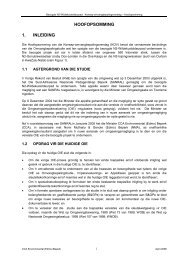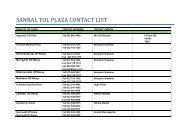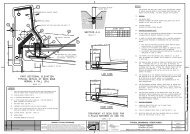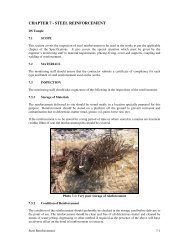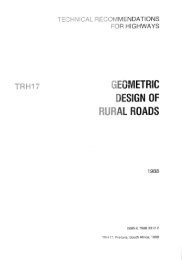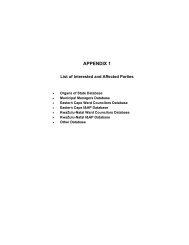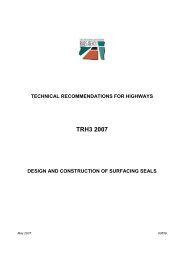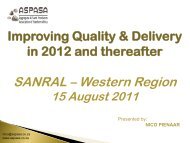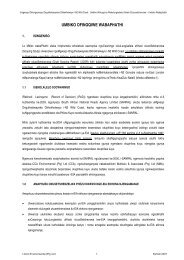SAPEM Chapter 2 - Sanral
SAPEM Chapter 2 - Sanral
SAPEM Chapter 2 - Sanral
Create successful ePaper yourself
Turn your PDF publications into a flip-book with our unique Google optimized e-Paper software.
South African Pavement Engineering Manual<br />
<strong>Chapter</strong> 2: Pavement Composition and Behaviour<br />
CHAPTER CONTEXT<br />
The South African Pavement Engineering Manual (<strong>SAPEM</strong>) is a reference manual for all aspects of pavement<br />
engineering. <strong>SAPEM</strong> is a best practice guide. There are many appropriate manuals and guidelines available for<br />
pavement engineering, which <strong>SAPEM</strong> does not replace. Rather, <strong>SAPEM</strong> provides details on these references, and<br />
where necessary, provides guidelines on their appropriate use. Where a topic is adequately covered in another<br />
guideline, the reference is provided. <strong>SAPEM</strong> strives to provide explanations of the basic concepts and terminology<br />
used in pavement engineering, and provides background information to the concepts and theories commonly used.<br />
<strong>SAPEM</strong> is appropriate for use at National, Provincial and Municipal level, as well as in the Metros. <strong>SAPEM</strong> is a<br />
valuable education and training tool, and is recommended reading for all entry level engineers, technologists and<br />
technicians involved in the pavement engineering industry. <strong>SAPEM</strong> is also useful for practising engineers who would<br />
like to access the latest appropriate reference guideline.<br />
<strong>SAPEM</strong> consists of 14 chapters. A brief description of each chapter is given below to provide the context for this<br />
chapter, <strong>Chapter</strong> 2.<br />
<strong>Chapter</strong> 1: Introduction discusses the application of this <strong>SAPEM</strong> manual, and the institutional responsibilities,<br />
statutory requirements, and, planning and time scheduling for pavement engineering projects. A glossary of terms<br />
and abbreviations used in all the <strong>SAPEM</strong> chapters is included in Appendix A.<br />
<strong>Chapter</strong> 2: Pavement Composition and Behaviour includes the history of roads from Roman times to modern<br />
roads, and the basic principles of roads, from political and technical perspectives. Typical pavement structures,<br />
material characteristics and pavement types, including both flexible and rigid pavements, and surfacings are given.<br />
The development of pavement distress is discussed (although more detail and illustrations are given in <strong>Chapter</strong> 14),<br />
along with the types of distresses usually associated with particular pavement types. The functional performance of<br />
pavements is also presented. As an introduction and background for reference with other chapters, particularly<br />
<strong>Chapter</strong> 10, the basic principles of mechanics of materials and material science are outlined. Climatic issues,<br />
variability in pavements and life-cycle strategies are also covered.<br />
<strong>Chapter</strong> 3: Materials Testing presents the tests used for all material types used in pavement structures. The<br />
tests are briefly described, and reference is made to the test number and where to obtain the full test method.<br />
Where possible and applicable, interesting observations or experiences with the tests are mentioned. <strong>Chapter</strong>s 3 and<br />
4 are complementary.<br />
<strong>Chapter</strong> 4: Standards follows the same format as <strong>Chapter</strong> 3, but discusses the standards used for the various<br />
tests. This includes applicable limits (minimum and maximum values) for test results. Material classification systems<br />
are given, as are guidelines on mix and materials composition.<br />
<strong>Chapter</strong> 5: Laboratory Management covers laboratory quality management, testing personnel, test methods,<br />
and the testing environment and equipment. Quality assurance issues, and health, safety and the environment are<br />
also discussed.<br />
<strong>Chapter</strong> 6: Road Prism and Pavement Investigation discusses all aspects of the road prism and pavement<br />
investigations, including legal and environmental requirements, materials testing, and the reporting of the<br />
investigations. <strong>Chapter</strong>s 6 and 7 are complementary.<br />
<strong>Chapter</strong> 7: Geotechnical Investigations and Design Considerations covers the investigations into potential<br />
problem subgrades, fills, cuts, structures and tunnels. Guidelines for the reporting of the investigations are provided.<br />
<strong>Chapter</strong> 8: Material Sources provides information for sourcing materials from project quarries and borrow pits,<br />
commercial materials sources and alternative sources.<br />
<strong>Chapter</strong> 9: Materials Utilisation and Design discusses materials in the roadbed, earthworks (including cuts and<br />
fills) and all the pavement layers, including soils and gravels, crushed stones, cementitious materials, primes, stone<br />
precoating fluids and tack coats, bituminous binders, bitumen stabilised materials, asphalt, spray seals and micro<br />
surfacings, concrete, proprietary and certified products and block paving. The mix designs of all materials are<br />
discussed.<br />
<strong>Chapter</strong> 10: Pavement Design presents the philosophy of pavement design, methods of estimating design traffic<br />
and the pavement investigation process. Methods of structural capacity estimation for flexible, rigid and concrete<br />
block pavements are discussed.<br />
Preliminary Section<br />
Page ii





